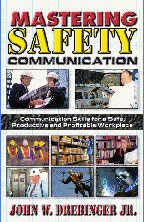Mastering Safety Communication
 Available in Print $14.95
Available in Print $14.95
Print Version $14.95
Available in Digital eBook $12.97
Digital eBook Version $12.97
(System Requirements for Digital eBook: You must have an eReader device such as Kindle, Nook, iPad, iPhone, Android Tablet, Android Phone, OR you may read it on your computer using Adobe Reader)
Technical Support for eBook Reader’s (Click Here)
Over 80,000 copies sold, more than any other book in the field of safety!
(Bulk Discounts and Expedited Shipping – Available Call In Orders Only) Call 209-747-2770
This is the most important book on communicating your safety message you could own.
Five years in the writing, it’s the first and only book written specifically for safety professionals by a Certified Speaking Professional. For the first time ever, safety speaker John lays bare his exact system for making safety fun and interesting. You’ll find more communication tips on any two pages of this book than you’ll find in the entire manuscripts of other so-called how-to books.
What’s Inside:
CHAPTER ONE: How To Use This Book
- Write Down Your Ideas
- Questions Can Be Your Compass
- Reading This Book Effectively
CHAPTER TWO: Communication Philosophy
- There Are No Rules! Well Maybe One!
- Taking Personal Responsibility Is Vital To A Safe Workplace
- In Order To Make A Difference, You Must Believe You Can Make A Difference
- Changing Who We Are Is How We Move To The Next Level Of Excellence
- Create For Yourself The Role Of Someone Who Helps Supervisors Achieve A Safe Workplace
- Reinforce In Your Mind And Others That You Are Effective
- Safety Professionals Affect Company Profits
- Learning, Communicating and Entertaining
- Have Fun!
- Do You Enjoy Results Or Just The Struggle?
- Believe In Yourself And What You Do
CHAPTER THREE: Representational Systems
- What Are Representational Systems?
- Primary Representational System
- How To Use Representational Systems Effectively
- Analysis of Sensory Words Used In Story
- Examples of Representational System Words
- Which Is Your Primary Representational System?
CHAPTER FOUR: Rapport Skills
- The Magic Of Rapport
- Matching and Mirroring
- What Matching And Mirroring Is Not!
- More Detail On How To Match And Mirror
- Rules: “Look To Talk” and “Look To Listen”
- When Not To Use Matching and Mirroring
- Five Things To Match In Getting Rapport
- Cross Over Mirroring
- How Do You Know You Have Rapport?
- How To Achieve Rapport With A Room Full Of People
CHAPTER FIVE: Motivation of Yourself and Others
- Take Responsibility For Training Results
- Making Safety Communication Important To You
- How To Build Passion
- Making A Difference
- Motivation Idea – Choice
- “Safety,” Their Viewpoint Or Yours
- Safety And Production
- The Magic Of High Expectations
- Safety Is A Team Effort
- Taking Responsibility For Others Safety
- Motivation of Safety Professionals
- Reinforcing Your Own Effective Self Image
- Build Strong Beliefs About Your Effectiveness
- Evaluation Forms
- Doing Whatever It Takes
- Passion
CHAPTER SIX: Inspirational Learning
- A Positive Effect Of Copying Behavior
- A Bonus Of Working For A Safety Conscious Company
- One Way People Learn, On The Job Training
- Correcting Unsafe Behaviors Is A Must
- Being An Inspiration To Others
- Be A Student Of Excellence – Look For Similarities
CHAPTER SEVEN: Sandwich Style Criticism
- The Magic Of Sandwich Style Criticism
- Why Multiply Your Effectiveness
- Sandwich Style Criticism
- How To Come Up With A Positive List
- Planning Ahead For Spontaneity
CHAPTER EIGHT: Creative Ideas
- How People Get Into A Stuck State
- Getting Someone Out Of A Stuck State
- I Know You Don’t Know But If You Did Know?
- Activities You Can Do To Improve Imagination
- An Example Of The Evolution Of A Training Technique
- Sharing Ideas With Others
CHAPTER NINE: What’s In A Word?
- Language and Thinking
- Words – The Keys To Your Thoughts
- Change The Meaning – Change The Feeling
- Words You Say To Yourself
CHAPTER TEN: Outcomes
- Outcomes, Yours and theirs.
- Leaders Have Specific Outcomes
- Programming Your Brain To Achieve Your Outcomes
- Reach Higher Levels of Performance By Stretching Your Own Outcomes
- Helping Others Reach Higher Standards By Stretching Your Own Outcomes
- Guidelines For An Achievable Outcome
- State Your Outcome In The Positive
- Be Specific In What You Want
- Take Into Account Their Current Behavior
- Outcomes Initiated and Maintained By You
- Make Your Outcomes Sensory Specific
- Is It Compelling?
- Determine Specific Evidence Of Achievement
- Is It What You Really Want?
- Who Is This Outcome Up To?
- Do You Have A Choice Of Ways To Achieve It?
- Is The First Step Specified And Achievable?
- What Resources Do You Need To Achieve Your Outcome?
- Act As If
- Some Fine Tuning Questions To Ask
CHAPTER ELEVEN: LOGISTICS
- The Magic Of One Word
- Bad At Names? Here Is A Strategy That Works!
- Strategies and Successful Use Of Them
- Preferred Seating Arrangement
- Treating Trainees As An Audience
- Public Address Systems
- How Many People Are Hearing Impaired?
- The Magic Of Physiology
- Podium Use And It’s Negative Effect
- Use Your Notes In A Creative Way
- Make Some Training Meetings Special
- Taking Out Time For Training
- Handouts With Blank Spaces – A Clever Addition
- Taking Breaks
- Opportunities For Learning
- Plan Ahead For The Spontaneous
CHAPTER TWELVE: Effective Implementation
- Now Is The Time To Take Action!
- Action Is The Key To Success
- Thanks
Review of Mastering Safety Communication
Reprinted with permission from Professional Safety Magazine.
Mastering Safety Communication – Skills for a Safe, Productive and Profitable Workplace.
Most professionals like to have on their bookshelves how-to or hands-on books that they can use effectively in their day-to-day work. This book is one of those – but it is also backed up by the philosophy behind the recommendations. Thus, in this sense, it is more than a how-to book.
The book is based on the author’s 19+ years experience as an effective trainer, teacher, and professional speaker to audiences of both employees and managers. Scattered throughout the book are appropriate quotes by people from whom Drebinger has learned many ideas. One quote, perhaps more than any other, illustrates the book’s theme: “The outcomes you hold yourself accountable for are the ones you will achieve.”
Drebinger advocates keeping a journal and writing down ideas as they arise. He says, “Writing a journal not only creates a record of your life and ideas, (it) becomes a doorway to new ideas, decisions, and pathways in the future.” Several blank pages with the heading “What Ideas Can I Use to Improve the Safety Behavior of Myself and Those With Whom I Work?” are included near the end of the book.
The book has 12 short, hard-hitting chapters that give the reader the tools needed to develop an effective, individual communication style. A section entitled, “Questions to Enhance Your Reading”, prefaces each chapter. Near the book’s end, the author provides a “Collection of Empowering Quotes” as well as a recommended reading list. While aimed at safety professionals, this book is excellent for anyone who has the opportunity to communicate with, teach, and train people.
Dr. Milton Rhodes, CSP, Miami, FL
Available in Print $14.95
Print Version $14.95
Available in Digital eBook $12.97
Digital eBook Version $12.97
(System Requirements for Digital eBook: You must have an eReader device such as Kindle, Nook, iPad, iPhone, Android Tablet, Android Phone, OR you may read it on your computer using Adobe Reader)
Call John’s Office Today
(209) 327-4752
Watch This Testimonial Now! “You Had the Room”
John’s Free Newsletter! Get the latest safety communication tips from best selling author and international safety speaker John Drebinger. Just click on the subscribe button or Click Here.
Search Website
Are You Uncomfortable Speaking In Public? (Click Here More Info)
“No More Stage Fright – Say Goodbye to Fear” Overcome your fear of speaking in just 90 minutes, pain free.
- Diane Weiss - Marketing Director
- John Drebinger Presentations
- (209) 327-4752
- diane@drebinger.com







